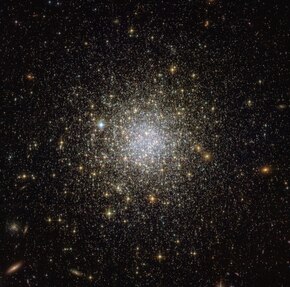NGC 1466
| NGC 1466 | |
|---|---|
 | |
| Observation data (J2000epoch) | |
| Constellation | Hydrus |
| Right ascension | 03h44m33s[1] |
| Declination | −71° 40′ 17″[1] |
| Distance | 48.5kpc(158kly)[2] |
| Apparent magnitude(V) | 11.4[3] |
| Apparent dimensions(V) | 3.50′[1] |
| Physical characteristics | |
| Mass | 1.4×105[4]M☉ |
| Metallicity | = −1.60[5]dex |
| Estimated age | 13.1[6]Gyr |
| Other designations | SL1, LW1, ESO54SC16, KMHK1,[1]PGC2802621 |
NGC 1466is theNew General Cataloguedesignation for aglobular clusterin the deep southernconstellationofHydrus.It is located in the outskirts of theLarge Magellanic Cloud,[5]which is asatellite galaxyof theMilky Way.The object was discovered November 26, 1834 by English astronomerJohn Herschel.[7]John Dreyerdescribed it as "pF, pS, iR, glbM, *7 f", meaning "pretty faint, pretty small, irregular round, gradually a little brighter middle, with a 7th magnitude star nearby".[8]When using a small telescope, this is a "faint, small, unresolved and difficult" target with anangular sizeof 1.9arc minutes.It has an integratedvisual magnitudeof 11.4.[3]
This cluster has a reddening correcteddistance modulusof18.43±0.15,[5]corresponding to a distance of 48.5 kpc.[2]The cluster has a mass of about 140,000 times themass of the Sun.[4]It is an old cluster, having an estimated age of 13.1 billion years.[5]In photographs, the cluster spans an apparent size of 3.50arc minutes.[1]The core radius has an angular size of10.7±0.4 arc seconds,[5]while the half-light radius is 24.3 arc seconds.[4]
There are a total of 49 known and one candidateRR Lyrae variablestars in the cluster, as of 2011. Eight are RRd, or double-mode RR Lyrae variables. The average periods are 0.591 days for RR Lyrae type ab and 0.335 days for RR Lyrae type c. These are consistent with a classification ofOosterhoff-intermediatefor the cluster. Twelve other variables have been identified, including two long-period variables and a Cepheid variable.[5]
References
[edit]- ^abcdeBica, E.; et al. (September 2008), "A general catalogue of extended objects in the Magellanic System",Monthly Notices of the Royal Astronomical Society,389(2): 678−690,arXiv:0806.3049,Bibcode:2008MNRAS.389..678B,doi:10.1111/j.1365-2966.2008.13612.x,S2CID1867090.
- ^abThe distancedin parsecs is given by:
- d= 10(m-M+ 5)/5= 104.686= 48,528.9
Webb, Stephen (1999),Measuring the Universe: The Cosmological Distance Ladder,Springer Science & Business Media, p. 76,ISBN978-1852331061. - ^abInglis, Mike (2013),Observer's Guide to Star Clusters,The Patrick Moore Practical Astronomy Series, Springer Science & Business Media, p. 128,Bibcode:2013ogsc.book.....I,ISBN978-1461475675.
- ^abcNoyola, E.; Gebhardt, K. (September 2007), "Surface Brightness Profiles for a Sample of LMC, SMC, and Fornax Galaxy Globular Clusters",The Astronomical Journal,134(3): 912−925,arXiv:0705.3464,Bibcode:2007AJ....134..912N,doi:10.1086/520061,S2CID33640.See table 5.
- ^abcdefKuehn, Charles A.; et al. (October 2011), "Variable Stars in Large Magellanic Cloud Globular Clusters. I. NGC 1466",The Astronomical Journal,142(4): 14,arXiv:1107.5515,Bibcode:2011AJ....142..107K,doi:10.1088/0004-6256/142/4/107,S2CID119199717,107.
- ^Santos, J. F. C. Jr.; Piatti, A. E. (December 2004), "Ages and metallicities of star clusters: New calibrations and diagnostic diagrams from visible integrated spectra",Astronomy and Astrophysics,428:79−88,arXiv:astro-ph/0409313,Bibcode:2004A&A...428...79S,doi:10.1051/0004-6361:20041560,S2CID11068323.
- ^Seligman, Courtney,"NGC Objects: NGC 1450 - 1499",Celestial Atlas,retrieved2016-12-14.
- ^Dreyer, J. L. E. (1888), "A New General Catalogue of Nebulæ and Clusters of Stars, being the Catalogue of the late Sir John F. W. Herschel, Bart, revised, corrected, and enlarged",Memoirs of the Royal Astronomical Society,49:1,Bibcode:1888MmRAS..49....1D
External links
[edit] Media related toNGC 1466at Wikimedia Commons
Media related toNGC 1466at Wikimedia Commons

![{\displaystyle {\begin{smallmatrix}\left[{\ce {Fe}}/{\ce {H}}\right]\end{smallmatrix}}}](https://wikimedia.org/api/rest_v1/media/math/render/svg/4c0821bd80891e071c08e7c7ee8e022baedf522c)